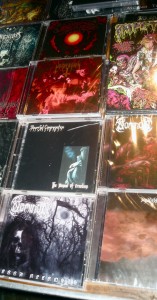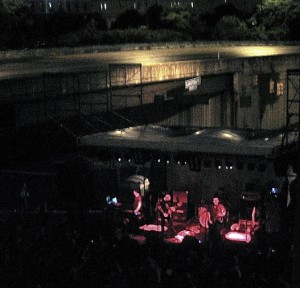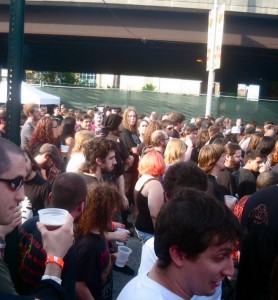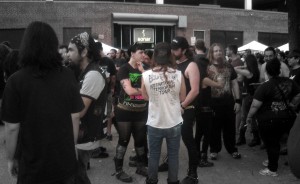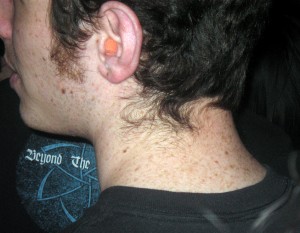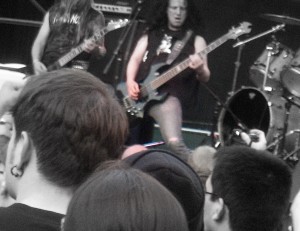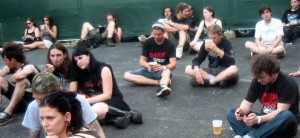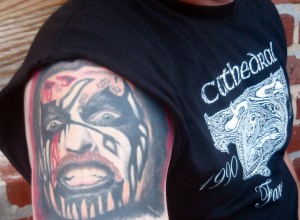my guest blog on Social Shutter Re: Maryland Deathfest 2011
by Leonard Nevarez on Jun 15, 2011 • 8:00 pm No CommentsThis week the visual urban sociology blog Social Shutter ran my photos and a new essay about Maryland Deathfest. If you didn’t see the post, I’ve reprinted it below. And do check out Social Shutter, where Georgia State University sociologist Deirdre Oakley and her students offer some compelling and provocative photoessays.
Deathfest
Posted by Leonard Nevarez, BALTIMORE, MD — The Maryland Deathfest (MDF) is the biggest festival for “extreme heavy metal” in the U.S. – and, so far as I know, the only urban festival in North America for heavy metal of any kind. Since 2003, the event has drawn performers and fans from metal’s most controversial sub-genres: death metal, grindcore, black metal, doom metal, crust punk, stoner rock, and their various hybrids. These are the sounds that make parents around the world freak out if discovered in their kids’ iPods. On the whole, this music is bracing in its volume, speed, and discordance; the bands’ names and lyrical content are intentionally blasphemous or stomach-churning; and vocalists’ guttural growls and raspy screams convey the experience of eternal damnation and the despair at humanity’s inevitable extinction.
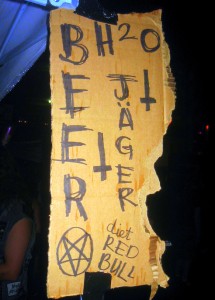 Needless to say, none of this music comes within miles of the music charts. This is metal’s deepest underground, historically overlooked by the corporate music industry. Yet it has become a significant industry of independent recording labels, music distributors, merchandise companies, music periodicals and blogs across the world. While few of these bands could play to sizable crowds by themselves, MDF provides them a rare critical mass of consumers and media attention. In turn, bands and listeners alike have lauded MDF for its discerning taste and global scan in selecting the most exciting and obscure bands in extreme metal. This year the 63 bands on the festival schedule came from 17 nations across 4 continents. Predictably, Scandinavia was well represented (Satanic black metal being almost synonymous with Norway), but even Greece and Saudi Arabia yielded excellent groups.
Needless to say, none of this music comes within miles of the music charts. This is metal’s deepest underground, historically overlooked by the corporate music industry. Yet it has become a significant industry of independent recording labels, music distributors, merchandise companies, music periodicals and blogs across the world. While few of these bands could play to sizable crowds by themselves, MDF provides them a rare critical mass of consumers and media attention. In turn, bands and listeners alike have lauded MDF for its discerning taste and global scan in selecting the most exciting and obscure bands in extreme metal. This year the 63 bands on the festival schedule came from 17 nations across 4 continents. Predictably, Scandinavia was well represented (Satanic black metal being almost synonymous with Norway), but even Greece and Saudi Arabia yielded excellent groups.
Admittedly, I’d lost touch with heavy metal’s evolution since the 1980s and early 90s, the years when thrash metal (the first extreme sub-genre: Metallica, Slayer, etc.) flourished, and hardcore punk crossed over subculturally into the metal underground. By that time, as cultural critics and sociologists of subculture have observed retrospectively, those musical developments contributed to the consolidation of the peculiarly omnivorous yet ironic cultural sensibility associated with the post-punk “neo-bohemia”, captured so well in Richard Lloyd’s Neo Bohemia and Ryan Moore’s Sells Like Teen Spirit. Metal has since fallen largely under the pop-cultural radar, so I was eager for a quick submersion back into its underground.
As an urban sociologist, I was also interested in MDF’s social and geographic insertion into central-city Baltimore. Like so many other American rustbelt cities, Baltimore has continually lost population over the post-WWII era, having shrunk by almost a third since 1950. Yet since 2000, according to the most recent American Community Survey, the 25-34 age group has increased, and now represents 16.7 percent of the city’s total population. Evidence of a thriving bohemian enclave can be found around Baltimore, particularly the neighborhoods surrounding Johns Hopkins University. In these neighborhoods independently-owned coffeeshops flourish, along with renown record and zine stores; fashion boutiques and giftshops that incorporate with a wink the city’s 1960s-era aesthetic (best captured by the films of local hero John Waters); and a small but celebrated local indie-rock scene (epitomized by Beach House, Dan Deacon, and Wye Oak). Traditionally, heavy metal isn’t associated with urban music scenes so much as state/national distinctions and the suburban landscapes of adolescent alienation. However, I wondered if the elevated degree of musical/subcultural connoisseurship illustrated by MDF’s organizers and attendees reveals an emerging identification with the distressed-brick exteriors and haunted cityscapes favored by so many contemporary urban bohemians.
Three days in Baltimore at Deathfest provided much food for thought, if only speculative at this stage, as well as ringing ears. Video footage from this year’s MDF can be found all over the internet. Decibel Magazine’s videos are a good place to start but watch the volume.
Leonard Nevarez is an associate professor of sociology at Vassar College. He is the author of two books, Pursuing Quality of Life and New Money, Nice Town. You can read more about Maryland Deathfest and view the rest of Leonard’s photostreamon his blog Musical Urbanism. He can be contacted at lenevarez@vassar.edu.


